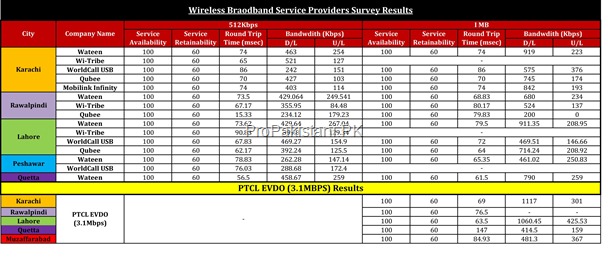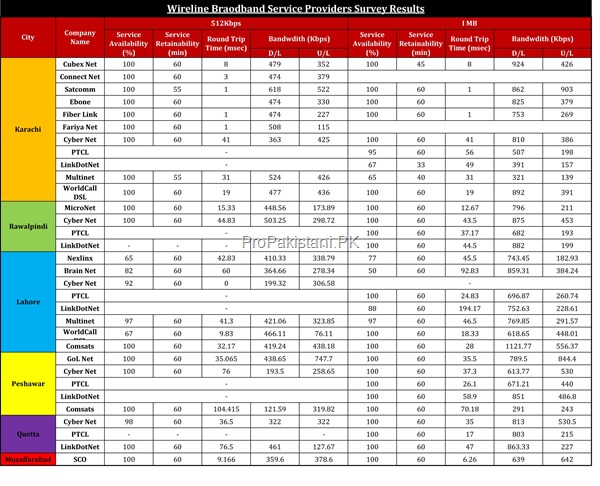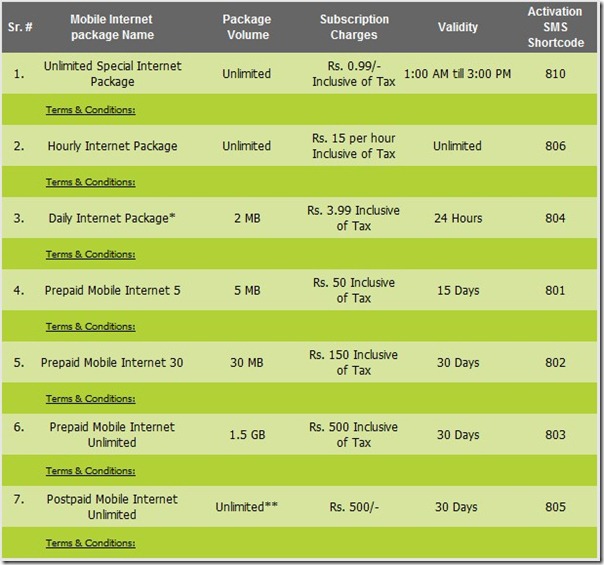As we earlier reported, Pakistan Telecommunication Authority had conducted this Quality of Service survey for wireless and wireline broadband operators throughout the country during third and fourth quarter of 2011.
Authority has now made the survey results public, which we are presenting for our readers.
Performance Indicators:
During Quality of Service (QoS) survey
PTA considered following indicators:
- Service Availability,
- Download and Upload bandwidth Speed,
- Round-Trip Time (RTT)
- Retain-ability.
Broadband Service Availability indicates the number of times PTA was able to successfully access the broadband services. The bandwidth speed is the measure of how much data a
subscriber can receive or send to the maximum for different tariffs. RTT is the time taken for the data packet to reach a particular destination and return.
Retain-ability is measure of how much time a connection remained connected during the period of 60 minutes.
PTA said that it graded each QoS parameter into Grade A, B, C, D and E based on the
percentage of score obtained during the measurement.
512 Kbps Packages:
For 512Kbps broadband package of wireless broadband service providers, Wateen Telecom has been placed in Category-A in Lahore, Rawalpindi, Karachi and Quetta and Category-B in Peshawar.
Similarly Wi-Tribe in Karachi and Rawalpindi/Islamabad, Qubee in Lahore and Rawalpindi and WorldCall in Lahore are placed in Category-A. Qubee and WorldCall in Karachi and Wi-Tribe in Lahore are placed at Category-B.
Similarly for 512Kbps broadband package of wireline broadband service providers, Cyber Net was placed in Category-A in Karachi, Rawalpindi/Islamabad and Quetta whereas in Category-B in Lahore and Peshawar. MicroNet (NayaTel) in Category-A in Rawalpindi/Islamabad.
1 Mbps Packages
For 1Mbps broadband package of wireless broadband service providers, Wateen Telecom has been placed in Category-A in Lahore and Rawalpindi/Islamabad and Category-B in Karachi, Quetta and Peshawar.
Similarly Qubee and WorldCall are in Category-A at Lahore and Category-B at Karachi and Wi-Tribe is in Category-B at Rawalpindi/Islamabad.
Similarly for 1Mbps broadband package of wireline broadband service providers, PTCL has been placed in Category-A in Lahore, Rawalpindi/Islamabad, Peshawar and Quetta and in Category-B in Karachi.
LinkDotNet has obtained Category-A in Rawalpindi/Islamabad and Quetta and in Lahore in Category-C. Whereas, MicroNet has been placed in Category-A in Rawalpindi/Islamabad.
Wireless Broadband Operators:
Check below the detailed table with scores for all wireless operators in different cities:

Click on image for larger view
Following is the overall standing of wireless operators; this table doesn’t indicate the ranks, rather shows the rating of operators in number of cities where service was surveyed.
For instance, Wateen was tested in 10 cities, out of which it scored A in 6 cities while Grade B in 4 cities.

Note: Click on image for larger view
Wire-line Operators:

Note: Click on image for larger view

Note: Click on image for larger view














